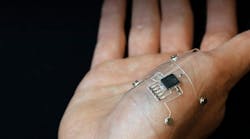Engineers at the Air Force Research Laboratory worked with colleagues at Harvard University to develop a new way to “print” stretchable, flexible electronics. The process, dubbed Hybrid 3D printing, uses additive manufacturing to combine soft, conductive inks with a material substrate to wind up with stretchable, wearable electronic devices.
“This is the first time a 3D printer has printed, in a single process, stretchable sensors with integrated microelectronic components,” says Dan Berrigan, a research scientist at the Air Force Research Lab. “Starting from nothing, the printer builds an entire stretchable circuit that blends the mechanical durability of printed components with the robust performance of off-the-shelf electronics.”
In the lab, the researchers used a 3D printer to create conductive traces of flexible, silver-infused thermoplastic polyurethane. A pick-and-place method was then used to install microcontroller chips and LEDs into the flexible substrate, augmented by an empty printer nozzle and vacuum device to create the hybrid circuits.
When tested, the hybrid-electronic devices could function even after being stretched by more than 30% from the original size.
“This has a lot of potential for Air Force applications, particularly in the areas of rapid prototyping, wearable electronics, sensors, and human performance monitoring,” says Berrigan. “Skin-worn electronics could provide feedback on movement, body temperature, fatigue, hydration, and other metrics crucial to understanding pilot and aircrew performance. However, while skin is inherently soft and stretchable, electronics and sensors are not.”
As part of the study, the team printed sensors and placed microelectronics into them, then mounted them on spandex sleeves. They were able to respond to the movement of the wearer’s arm. The researchers also created a pressure sensor for shoes that can sense and monitor gait. They are also investigating the possibility of using the same methods to build antennas and sensors into structures.
One challenge the team is focusing on for future work will address powering the devices, which would require a stretchable battery or other printed power source to be added into the manufacturing process. Developing a durable, flexible, and high energy-density battery has been difficult because what makes a good battery does not necessarily make for a good, soft-material system.
Though the materials and methodology are still in the early stages of development, the potential future application space is enormous.


